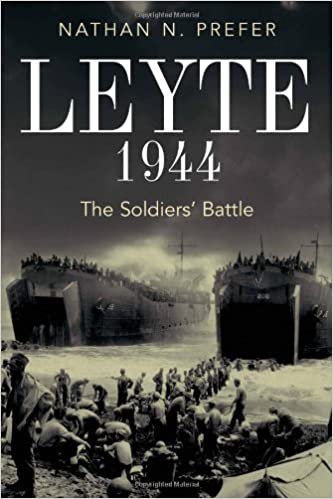Reviewed by Dr. Richard H. Gribling
Leyte 1944: The Soldiers’ Battle was written by Nathan N. Prefer, a military historian with graduate degrees in military history. His prior books include The Battle for Tinian: Vital Stepping Stone in America’s War Against Japan, Eisenhower’s Thorn on the Rhine: The Battles for the Colmar Pocket, 1944-45 and MacArthur’s New Guinea Campaign: March-August 1944.
When the reader first opens Leyte 1944, you are struck with the realization that this is a detailed account of the day to day slogging of intense ground combat as it played out in the Philippines Theater of Operation during World War II. The author does a good job of getting into the minds of the tactical commanders on both sides. This is accomplished because the book is magnificently referenced with an abundance of primary sources. The reader takes away the sense that the grimy battle fought in Leyte was a test of wills between resolute Japanese infantry battalions defending their homeland and a determined American force that accepted the high degree of violence but ultimately knew they would be victorious. Leyte 1944 has three main parts. First, it lays out the “why” of the allied strategy and explains the importance of launching the Philippines Operation at all. Early in Leyte 1944, the author describes the intense debate within the Joint Chiefs and the War Department as to whether all the energy and resources should be directed either at Formosa or the southern Philippine Islands. Only one option was feasible. Protection of the advancing US Naval Fleet and the ability to quickly build air bases to project power onto the home Japanese Islands was the deciding factor. It didn’t hurt to have the persuasive General Douglas MacArthur backing the Philippine side, as well.
Second, the reader gets a gruesome picture of attrition warfare where key terrain only counts as temporary leverage until the next attack begins against the next Japanese defensive position. Likewise, he realistically describes how the Japanese battalions, plagued with limited resources, could only respond with repeated counter attacks in order to slow the US ground gains. For the next six chapters, the reader vividly experiences the daily grind of troops (from both sides), moving through the unforgiving terrain of perpetual valley’s and mountains that strain the stamina and will of all concerned. The author ends this view in chapter 8, “The Last Valley”. What makes these detailed descriptions of the yard by yard of infantry fighting interesting, is the author’s successful ability to weave in the important operational objectives of the US regiments with the individual stories from the generals, colonels, captains, sergeants, and privates. The author wants the reader to understand that it’s the blood, sweat, and sacrifice of the individuals that made the ground war in Leyte successful.
Third, and finally, the author wraps up this detailed historical account in the last two chapters entitled “The Japanese Retreat and the Bitter End” which marks the last great decisive battles in the Leyte operation before the Japanese home islands could be invaded. At the end of the book, the author summarizes the importance of the Leyte experience when he quotes “General Yamashita who was testifying after the war to the US Military Commission saying, ‘After the loss of Leyte…I realized that decisive battle was impossible.’ Leyte then, had proven to be the decisive ground battle of the war in the Southwest Theater of Operations.’” (Prefer, page 312).
There is one distractor in this marvelous book that needs mentioning, however. The author writes an amazing detailed account of the daily grind of ground combat. But the reference maps do not compliment the excellent accounts. Better maps, in color, would add a good bit to the reader’s understanding of this intricate battlefield.
Dr. Richard H. Gribling, is a professor on the faculty of the Joint Combined Warfighting School for the past twelve years. He is a retired US Army colonel and is a contributor to the Great Captains series and Staff Ride contributor to the college.
Leyte 1944: The Soldiers’ Battle (Nathan N. Prefer, Casemate Publishers, Havertown, PA and Oxford, UK, 2012, Paperback 2019)


